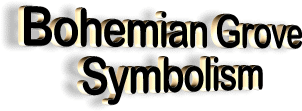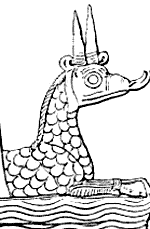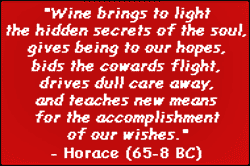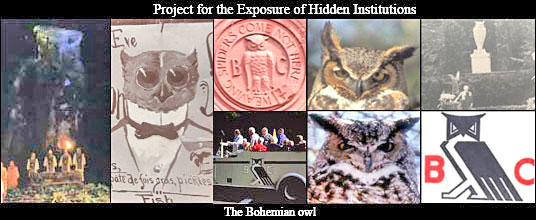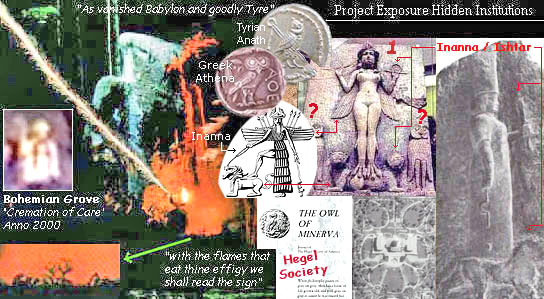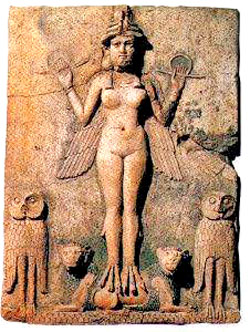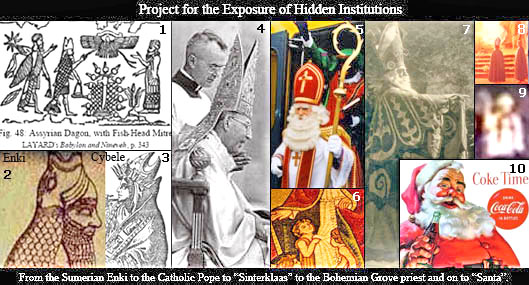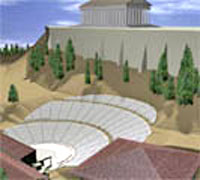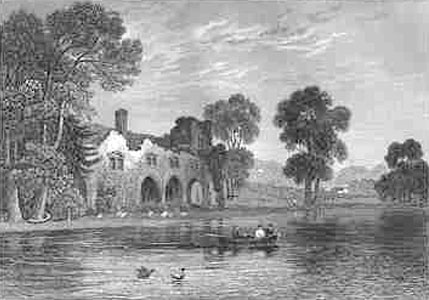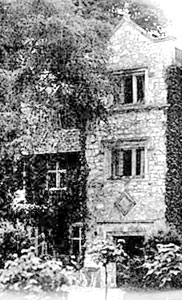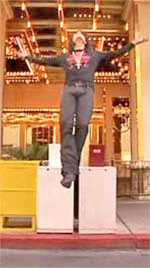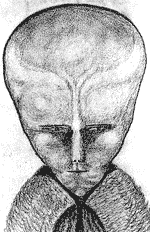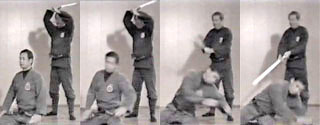|
|
|
by Joël van der Reijden from ExposureOfHiddenInstitutions Website
Although the Bohemian Grove concept is obviously inspired by ancient pagan customs it’s hard to define who came up with the original ideas or for what reason.
The people first involved with the Bohemian Club and the Bohemian Grove were a group of writers and artists who had a love for nature and were usually very opposed to the business ways of the robber barons. Nobody seems to have investigated it in the first place, but at this moment there’s no indication that any of the more important members of the Bohemian Club had an unusual interest in pagan rituals or practices.
On the other hand, Joseph D. Redding, the founder of the Cremation of Care and a president of the Bohemian Club, was very well connected to the elite Anglo-American families, so who knows where he got his inspiration from (more about him later).
There is also the prominent Bohemian Club member Ambrose Bierce who spent 3 years in England before he came to San Francisco.
Bierce wrote ’The Devil’s Dictionary’, a book that shows us that at least some of the early members had a bit of knowledge about pagan customs. In both cases we really need to know more about these individuals before we can reach any conclusions. What I know about them has been included in their bios, which can be found in the membership list.
Following are excerpts of Bierce’s ’The Devil’s Dictionary’:
Always by a
Freemason, according to Bohemian Bierce.
Well, what do you know?
Respect for Christians and an aversion to human sacrifice, malthusian genocide, greed, and pollution of the environment. Not bad for a Bohemian Grove participant, now is it? The Devil’s Dictionary is a satirical work written over a period of about 25 years. Although you might get that impression, it has very little to do with the occult, satanism, or the devil, as some might fear at this moment. You won’t find many other words in the book dealing with this type of subject.
Still, the combination of Baal, Bacchus, the Druids, and Freemasons ("secret rites, grotesque ceremonies and fantastic costumes") is quite interesting in relation to the Bohemian Grove. Many people claim that Baal is worshipped during the opening ceremony and the ritual certainly shows some parallels with the rites associated with this ancient god.
Bacchus has also been associated with the Cremation of Care, just as the Druids (the Celtic music, for instance). Peter Martin Philips, who has attended a Grove meeting and talked to many of its members, wrote in his 1994 Ph.D dissertation (1):
The Roman Bacchus is the same as the more well known Greek Dionysus, the god of wine, sexual and ecstatic freedom, fertility, and celebration.
The purpose of their rites was
quite similar to the Bohemian Grove concept, i.e. the participants
were to leave behind any worries about their daily lives. Although I
have not been able to find the exact origin or meaning of Dull Care
(he’s
unhappy because of the death of his brother Don’t Care), the poem
above, written by a poet from the Roman Empire and the earliest
reference I could find, shows it has a strong connection to wine
also, just as Bacchus and Dionysus.
The term was used quite frequently since at
least the late 17th century in Britain as the poems in
the left column show. The first reference since Horace that I was
able to find was the 1687 play ’Begone, Dull Care’ of [John] Playford:
Musical Companion, located in England. The emigrating poets and
writers took the term to the United States and many of them ended up
in San Francisco.
The de Vere family was involved in the practice of Royal Witchcraft (2) and his family considered themselves members of the Archdruid-Dragon race. Bacchanalian practices were well known within this group (more about that later).
The Bohemian Club’s primary motto, "Weaving Spiders, Come Not Here," also originated from them. It was taken from the second scene of Act 2 from ’A Midsummer Night’s Dream’, written by Shakespeare, who got at least some of his inspiration from Edward de Vere (who’s lateral descendant we coincidentally quoted throughout this article), although a case can be made that de Vere wrote pretty much all of the stuff that has been attributed to him. (3)
The theme of Dull Care, however, was not part of Shakespeare’s original MacBeth, but in the 1847 version of Giuseppe Verdi a reference to Dull Care was made by Lady MacBeth (which you can find in the column on the left).
And to get back to
the Bacon group, they have been responsible for the British
colonization of the United States, whom Bacon thought was ’The New
Atlantis’ (4), while especially
the Cecils and many of their blood
relatives played a major role in creating the British and later
Anglo-American empire. As you’ll see a bit further in the article,
the elite Anglo-American families could well have had a hand in the
creation of the Cremation of Care ceremony.
Robin Wood, a magic-enthusiast explains it a bit further (5):
Under normal circumstances one might not contemplate the alternative meaning of the word ’grove’, especially not when newspapers referred to a ’redwood grove’ ever since the day the Bohemians bought their initial 160 acres in 1899.
Still, the decision to hire a piece of land in the redwood grove was made in the early 1890s under the Bohemian Club presidency of Joseph D. Redding. At the same time he created the original Cremation of Care ceremony and acted as its High Priest. Redding had a completely different background than the average Bohemian Club artist.
His father was a land agent for the Southern Pacific Railroad Company, which was owned by the elite Anglo-American Pilgrims Society families, Harriman (chair of Southern and Union Pacific was Edward Henry Harriman, who was financed by Jacob Schiff) & Harkness (major shareholders of Rockefeller’s Standard Oil; intermarried with the Stillmans, who also intermarried with the Rockefellers; partners of J.P. Morgan; co-founders of the Commonwealth Fund and the Pilgrim Trust).
Redding went to Harvard Law School and became a wealthy lawyer for Southern Pacific. Southern Pacific is a great example of the reported schism that happened within the Bohemian Club between the original middle class artists and the wealthy businessmen. In May 1898 Southern Pacific created Sunset Magazine, which dealt with the outdoors, artistic writings, and things about everyday life. In 1911 Charles K. Field, a member of the Bohemian Club, became its editor.
Bohemian Club writers like Ina Coolbrith,
Jack London, Bret Harte, and John Muir contributed to the magazine,
but as time progressed all these writers became increasingly
critical of the business ways of the robber barons. Because of this
development Southern Pacific had to do away with the magazine in
1914. And by this time the Cremation of Care founder was living in
New York, surrounded by members of the Pilgrims Society.
The original Bohemians were a group of penniless rebellious young artists living in 19th century France. Among them were Victor Hugo (wrote ’Hunchback of the Notre Dame’ and is today an inspiration for the elite European Institute), Arthur Rimbaud, Alfred De Musset, and Paul Verlaine. Those who referred to these people as ’Bohemians’ meant that they thought of them as Gypsies (low life). The first accusation we know of was made in 1834 by Felix Pyat in a Parisian publication called ’Nouveau Tableau de Paris au XIX Siecle’.
It read:
The Frenchman Henry Murger was the first to popularize the term in his 1849 novel ’Scenes de la Boheme’, which was turned into a play 2 years later. In this book the main character, together with a few newly found friends, is involved in creating a small unofficial Bohemian club at a local Parisian tavern. Murger’s description of a Bohemian is someone who purely lives of the art he creates.
Bohemia, according to him, was located in Paris. So, I guess it’s pretty obvious to see where the San Francisco artists got their inspiration from when they established the Bohemian Club in 1872.
And they might have been totally different persons then those who inspired the creation of the Cremation of Care.
Today, when the average person sees pictures or videos of the Cremation of Care ritual they will usually get away with an entirely different impression.
Who would ever have imagined that the president of the United States, together with a large chunk of America’s elite, attends a yearly gathering where an ancient Babylonian (mock) human sacrifice is carried out in front of huge stone owl?
The original Bohemians were quite eccentric (and the absolute opposite of today’s Grovers), but this is just too bizarre. So whatever the owl meant for the early Bohemian Clubbers, it is quite reasonable to philosophize a bit about what the owl is supposed to represent these days. After all, the Cremation of Care was devised by a not-so-average Bohemian and the giant stone owl was only put into place in the 1920s when the Grove already was an elite gathering for at least 10 to 15 years.
In fact, the nationwide coverage of the Cremation of Care Ceremony around the turn of the century seemed to have drawn in lots of important people.
Traditionally, at least in conspiracy land, the owl in the Grove is associated with Moloch, although more and more people start to ask questions about that assumption. The reason for that is if you compare the above images with the descriptions and depictions of Moloch (below) you’ll find that there’s quite a difference.
I have never seen a non-Bohemian Grove related article in which Moloch is associated with an owl.
But even though I don’t interpret the Bohemian owl as Moloch/Baal, the Cremation of Care is very similar to the ancient rites associated with this sun god.
In the left column you can find a
detailed transcript of the rites of Melqart, the Tyrian version of
Baal and Molech, and how these spread to the Druids. More
information about similar rites can be found further down in this
article.
Stories
are completely incoherent and often you can make anything of it that
you want. Each new civilization copied the gods from the previous
one and it is obvious that many mistakes (or deliberate changes)
were made during this process. This is the reason that modern
mythology, to a large extent, is nothing more than making "best
guesses" in defining which deity is associated with which earlier
deity. That also seems to go for the initiates of secret societies.
Then there are mother and moon goddesses. The first one is usually associated with the dove or a lion (and is the partner and mother of different sun gods).
These are generally identified as the exact same goddesses. Goddesses associated with the moon, who are always closely related to the mother goddesses, are often depicted as an owl.
Going back further is hard, but we have a few leads.
There is a well known Sumerian clay tablet with a female deity depicted on it.
She is standing on two lions and is flanked by two owls [1]. Generally, this tablet is said to depict Lilith, a demoness, but the connections are weak and many scholars doubt this is the correct interpretation. Lilith has vaguely been associated with the "screech-owl", but that doesn’t automatically mean the tablet depicts this semi-goddess.
In my opinion the goddess Inanna would be a much better choice, because:
Even so, the question still remains who the owls on the clay tablet are supposed to represent, because the later civilizations seem to have reserved the owl for a separate deity.
Since Inanna’s parents were the moon god Nanna and the moon goddess Ningal, I guess I agree with those people that claim Inanna was also associated with the owl. But in the end we really can’t tell what the owl in the grove is supposed to represent.
Nicholas de Vere, a lateral inheritor of the Dragon title from the earlier mentioned extinct Earl of Oxford branch and a former head of the British Dragon Court (6), gives us another possibility of what the owl might mean to certain elite groups:
Maybe you noticed that I never mentioned the Egyptian mother goddess Isis.
The reason for that is the Egyptian pantheon often uses completely different attributes for the same deities than other parts of the ancient Middle-East. Although the owl could well represent Isis, we don’t need to worry about her, because she is certainly present at the Grove.
Peter Martin Phillips again:
The goddess Diana is also present at the
Grove. A picture of her statue, which is located near the ’Diana
Circle’, has been among a few dozen photos ’Kyle’ has managed to
snap in 2004 and 2005 as an employee at the Bohemian Grove.
(9)
The Mitre of the Bohemian Grove priest
Looking at the Bohemian Grove high priests [7-8-9] I noticed that they bear an uncanny similarity with a person known in the Netherlands as "Sinterklaas" [5], less commonly known as St. Nicholas of Myra, a bishop that lived in the 3rd and 4th century AD and was a member of the Council of Nicaea in 325.
The Americans changed his appearance to the more fluffy looking Santa Claus early in the 20th century. Not that I think the Bohemian Grove priest is Santa Claus, it’s just that the Catholic church has received all their inspiration from the earlier pagan religions.
The mitre, that also seems to reside on the heads of the Bohemian Grove priests, is one of the best examples of this. It represents the open mouth of the ancient half-man half-fish god that brought humankind civilization.
It was worshipped under different names: Enki,
Ea,
Dagon, and Oannes. Apsu (supposedly the origin of the Dragon race)
and Atargis are other half-man half-fish gods which are even older
than the sun gods. In the pictures above you can clearly see how the
process evolved.
What are those? Fishies? Brings back memories of that horror movie ’Dagon’,
originally written by Lovecraft.
The problem with the Dionysiacs and Bacchanalians
The cult became known for its extensive use of trance-inducing music, sex orgies, wine consumption, and the large amount of violent sacrifices, which, at least in the earlier stages, included humans. As a mystery cult it had public and secret rites.
One of the rites included the Maenads, a group of insane woman involved in bizarre blood rituals. This included the ripping apart of human beings and eating their flesh. During this time they were possessed by Bacchus who provided them with superhuman strength (11).
Nicholas de Vere, in his book ’The Origin of The Dragon Lords of the Rings’, adds:
Theater of Dionysus
After the cult ended up in Athens in the 5th century B.C. they build a theater in honor of Dionysus on the southside of the Acropolis.
It was later remodeled in stone. In the Dionysic theaters of Greece and Rome many plays were held, usually centered around their respective mythologies. The beginning of every festival was always reserved for sacrifices. Most scholars are of the opinion that in those days the sacrifices didn’t include humans anymore, at least not publicly, but the amount of animals killed was quite substantial.
Among
the initiates were those that built the Tyrian Temple of Melqart,
who in turn were employed by King Solomon to build the first Jewish
temple at Mount Moriah in 969 B.C. Solomon has always been
considered an important magician to the members of various secret
societies and God is said to have given him control over the Jinn
(elemental beings that can be conjured up). These helped him to
build his temple and cities alongside his human employees.
Not long after the Templars arrived, the Order of the Garter and the Dragon Court were (re)established in Britain, hints of Rosicrucian initiations started to surface, and Enochian Magic was born, followed by the birth of Scottish Rite Freemasonry (for the more common man). Even the Dragon Court, quoting the Catholic dictionary, accepts that the Templars fled to Scotland and gave rise to Freemasonry there (15).
The worship of Bacchus also went along within some of the secret societies. One of the most notorious pleasure-seeking Bacchanalians of British history was Sir Francis Dashwood of the Hellfire Club (16), who, in the mid-1700s, had reserved a central role for Bacchus/Dionysus in his own rituals.
The "do what you will" quote, inscribed above the main entrance of the Medmenham Abbey (below images) where many of his rites were performed, served as an inspiration for Aleister Crowley.
Dashwood visited many European
royal courts in his younger years, ultimately becoming Chancellor of
the Exchequer and a member of the Privy Council (1761). Franklin, an
occasional visitor of the Hellfire Club, eventually became a
Founding Father of the New Atlantis, better known as the United
States of America.
This last group, headed by the Rothschild family, decided in the 19th century that it was time for the Jewish people to return to Palestine and allied themselves with the British Empire (in Quigley’s Round Table, headed by Robert Cecil, the 3rd Marquess of Salisbury) (17).
This merging of the different elements, which is also what probably happened at the Bohemian Grove, is supported by Nicholas de Vere in ’The Origin of The Dragon Lords of the Rings’:
Benjamin Disraeli, the first Jewish Prime Minister of England and a close friend to both the Rothschilds and the Cecils, used to refer to Queen Victoria as "the Faery", which is usually thought of as nothing significant.
However, looking at Disraeli, a Knight of the Garter, a friend to the founders of the Round Table, and in the know of the influence of secret societies, it is probably a reference to Edmund Spencer’s story "The Faery Queen" (as he called Queen Elizabeth I) which also featured a "Red Cross Knight" (Rosicrucian).
Spenser was part of the Francis Bacon group and a close friend to John Dee, who is the founder of Enochian Magic and credited with writing ’The Rosicrucian Secrets’. Spenser dedicated several works to Dee’s student, Edward de Vere, who he is supposed to have visited on a regular basis (de Vere married Lady Anne Cecil and early on lived in the household of Sir William Cecil).
Nicholas de Vere, in ’From Transylvania to Tunbridge Wells’, adds:
And in ’The Origin of The Dragon Lords of the Rings’:
It’s hard to tell how many of these practices are still going on today.
If we stick to the non-criminal aspects, all I have come across are some stories about Tony Blair, who gets his advice from ’the light’ (18), and his eccentric New Age wife, who likes to drag her husband into Aztec rebirth rituals (19) and other standard paranormal practices (20). Then there are some reports about astrologers helping members of the royal house, which aren’t really worth repeating here (gossips).
Keep in mind that these are/were the most prominent persons in Britain of the past 10 years.
The old dynastic blue blood families seldom reach the news in the first place. Another interesting fact is that politicians and Anglican church officials are regularly invited into Druid groves.
When this is reported in the news the usual response is that "it’s perfectly Christian", although a detailed explanation is seldom, if ever given.
I think it’s a bit strange that Christian leaders do not actively attempt to take away people’s concerns when they join certain organizations (formerly?) associated with pagan practices.
Nicholas de Vere, in ’The Origin of The Dragon Lords of the Rings’, wrote:
Make of it what you will. Among the more prominent officials that have been invited into Druid groves are:
Undoubtedly this is only the tip of iceberg, but individuals aren’t exactly forthcoming about these aspects of their lives.
This is not at all to say that these people are wicked. After all, it is part of their history. It’s just that some of the publicly known groves have a lot of similarities with the Masonic groups of which a certain degree of secrecy and elitism is a basic ingredient.
In both cases the participants come to their groves and lodges to "discuss literature, poetry, music and art" and maybe to do a bit of tree-hugging or to perform a few dusty old rituals. In case of the Bohemian Grove a lot of these people come there to network, although they’re all pretending not do to that ("makes it easier to pick up the phone").
But all these groves, just as all the publicly known Masonic degrees, are only supposed to be outer circles anyway, part of the ’association of helpers’ so to speak, so who really cares what the participants think.
Conclusion
We’ve gone all over the Middle-East, Mainland Europe, England, and the United States, but still some of the basic questions have not been answered (to most people’s satisfaction). Who or what is the owl supposed to represent and do the Bohemians themselves have any idea?
To some it might refer to ancient Greece (Athena), which has always served as a great inspiration to the western world. Others might be of the opinion that it is a reference to Ishtar or Inanna.
Still others
might be of the opinion that it symbolizes Lilith and her Dragon
lineage. And still others undoubtedly think the owl is nothing more
then the Bohemian Club symbol. Then again, is the owl surrounding
the capitol building just a coincidence?
To be honest, I am not that interested in the Bohemian Grove all by itself and this article has largely been just an excuse to dabble a bit in the mystical aspects of the globalist movement and to look for the origins of some of its perversions (which we will focus on in the future).
Western mysticism is elitist, seems to have great
influence over the more mainstream religions, is hopelessly
intertwined with politics, banking, law, and intelligence, and if
you look below the thin layer of paint, you’ll see that most of the
upper level people don’t seem to have any degree of spiritual
enlightenment whatsoever.
Even regular artists (take Iron Maiden) (24) are fond of doing that, but this certainly has always been a specific trait of Rosicrucianism, Freemasonry, Druidism, or any other mystery religion. Shakespeare, or the 17th Earl of Oxford if you will, is often cited as an example and Joseph D. Redding might well turn out to be another one.
But in the end your guess is
as good as mine.
Masaaki Hatsumi, the only grand master of ninjutsu still alive, wrote (25):
From his writings it is clear that Hatsumi is no fan of magic and he once wrote it "leads to ruin," or something like that.
On the other hand, even with all his personal experience, I get the impression that Hatsumi only spoke from a historical Japanese point of view, which was seemingly filled with mischievous magicians/illusionists who were only after personal gain (and now that I am thinking of it, how about our own past?).
I think that a recent show like Mindfreak (a US illusionist) is great, because it gets people thinking and studying about things we all should be aware of.
If we exclude the theory that hundreds of witnesses have been bought for each individual episode (and no one has reported that yet), the show does provide serious evidence to everyone that the laws of reality can be bend to the extreme, whether that’s due to a ’what you see is what you get’ effect or due to a form of mind control.
Think of the military potentials alone, the secrecy that would surround it, and how this would be maintained (by messing with one’s mind).
Solomon, who’s every magician’s inspiration (the two Masonic pillars refer to the two pillars of his temple), is reported to have been a master in it.
John Dee, a teacher of de Vere and associate of the Cecils, did this stuff together with Edward Kelley through their Enochian magic. In that case they definitely contacted the wrong beings who made them do things they weren’t exactly pleased with (26).
Arthur Balfour, a relative of the Cecils, was holding seances at his house contacting god-knows-what (27).
Crowley, supposedly once a protégé of the Cecils (28), was inspired by one of these beings and contacted numerous others. One of these other beings, Lam, looked an awful lot like a type of grey alien.
There’s much more to this story, especially if you look at some of the reports that have been made in recent years, but that’s a whole other article.
More Mindfreak. In one of his episodes he turns water into beer. Now what does that remind you of?
It doesn’t have to be a liquid though.
It is seemingly possible to change it in anything someone can
imagine.
Additional References
|

